Odds & Ends: Hour of Devastation, Part 1
Every set, I dedicate a column or two to my mailbag to see what questions all of you have about the new set. What exactly do you want to know about Hour of Devastation?
Here's the tweet I put out:
It's time for my #mtghou mailbag column. Please send me single tweet questions about the new set. #WotCStaff
— Mark Rosewater (@maro254) June 30, 2017
As always, I try to answer as many questions as I can, but here's why I might not answer your question:
- I have an allotted word count, which means that there are only so many questions I can get to.
- Someone else might have asked the same question. I will usually answer the first person who asks.
- Some questions I either don't know the answer to or don't feel qualified enough in the area to properly answer them.
- Some topics I'm not allowed to answer for all sorts of reasons, including spoilers for future sets.
With that out of the way, let's get to the questions.
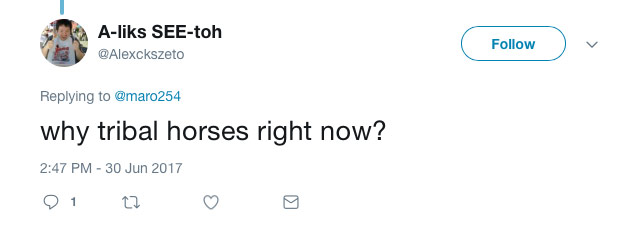
How a card gets designed and how its gets perceived after the fact are two very different things. Crested Sunmare is an excellent example. Perception is based on what aspect of the card pulls the most focus. Crested Sunmare is the first ever Horse tribal card. Therefore, the assumption is that the Horse tribal was the element that the card was built around, but it wasn't. In fact, the card probably didn't even have the word "Horse" in its rules text until well into development (and possibly later than that).
Crested Sunmare was created as a "build-around me" card to encourage players to make a "life-gain matters" deck. If you gain life, the reward was that you got a 5/5 creature token with indestructible. What creature was it? It wasn't anything. In early design we'll just use "NAME" as a placeholder, since the creature type isn't important to the design of the card. The design version of Crested Sunmare made "5/5 white NAME creature tokens with indestructible."
At some point, we realized that having the creature grant indestructible rather than putting it on each creature token was both cleaner (it required less memory about what each token did) and allowed the opponent an answer. If you could get rid of the Crested Sunmare, then you could destroy the creature tokens.
Interestingly, from a design standpoint, the creature type did matter, but in a way backwards from what you would think. It needed to be a creature type that wasn't on a lot of other creatures. If for example, the card had Zombie tribal (caring about and making Zombie creature tokens), it would significantly increase the power of the card—and the card was already pretty strong. This meant that we were looking for a less-used creature type.
We had two options. We could make a brand-new creature type such that this card would only interact with itself, or we could choose a creature type that already exists but at a low enough overall power level that it didn't force us to make this card cost more. My best guess is that the development team left this in the hands of the creative person who was concepting the set. ("Concepting" is the act of figuring out what each card creatively represents so art descriptions can be written.) I'm not 100% sure why Horse was chosen, but I'm guessing it hit the sweet spot of overlap between "Makes sense creatively on Amonkhet" and "It's a creature type that's low in number and overall power."
I got a bunch of mail from players who felt like a Horse tribal card came out of left field. And it did, but I think it's important that we do that from time to time. There's a lot of work we do to create things that players say they want, but it's important to create things that we think players will enjoy even if they've never asked for them. This was my social media preview card, and the reason I picked it is that I knew it would surprise and delight people.
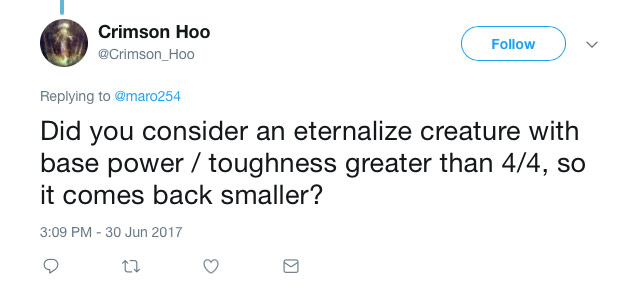
We talked about it because, usually when exploring design space, you tend to brainstorm about all aspects of the idea. In the end, we didn't find any designs we liked that pushed in that direction, so we didn't do it.
This question though brings up an important design lesson. There's a tendency when designing to want to push into what I call "blank space." Let me use eternalize as an example. Eternalize was a tweak on embalm where we changed two aspects of the mechanic, one major (the power and toughness) and one minor (the color). A big part of designing eternalize cards was finding mechanical space where the change to 4/4 meant something. The natural space for this was making creatures smaller than 4/4 so the change into a 4/4 was upside.
The "blank space" in this example (well, one of the blank spaces) was creatures larger than 4/4. What if eternalizing shrunk the creature when it came back as a 4/4? That would turn the mechanic on its ear. Blank spaces are attractive because they play into the vanity of the designer. It's exciting to create something that demonstrates how clever you are, that you pushed in a direction that players didn't anticipate.
The problem is that the point of game design isn't to be clever, it's to create a great game. So whenever you find yourself designing in blank space, you have to ask yourself whether your design serves the game. Are you creating something that improves the overall experience? It's easy to fool yourself because blank spaces have a high shock value. They create a strong first impression. Their weakness though comes out in play. A lot of unexplored spaces are unexplored for a reason. This is why playtesting is so important: because ideas that sound good on paper don't always end up playing well.
So why don't we have any larger creatures that shrink to a 4/4? Because we didn't find a design that made that decision choice improve the overall game experience. That's not to say they don't exist (maybe one day we'll reuse this mechanic and find a way to make that work), but we didn't do it just for the sake of doing it.
@mtg_tony: One thing I expected in this set and didn't see was lots of death triggers. This seems like the perfect set for them.
Hour of Devastation had a lot on its plate. It was picking up three of the four mechanics from Amonkhet—exert, aftermath, and cycling—and tweaking the fourth (eternalize instead of embalm). It added a new mechanic in afflict. It maintained the Zombie tribal theme, adding in a third faction of Zombies (the Eternals). It expanded greatly upon the "Deserts-matter" theme. It added three new Gods. It further played with the -1/-1 counter theme. It had to create more top-down Egyptian tropes. On top of all that, it had a brand-new story to tell that included both the destruction of Naktamun and the defeat of the Gatewatch.
Yes, death triggers would have been a thematic fit for the set, but there's only so much you can fit into one set, let alone a small second set that has responsibilities to carry over most of the themes of the large set that preceded it. Would it have been a great mechanical fit? It would have been okay, but it's not the slam dunk you might think. The graveyard interactions are about cards that come with value in the graveyard (embalm and aftermath). A block like Shadows over Innistrad that's more interested in the contents of your graveyard is happier with cards that want to get themselves into the graveyard. If I chump block with my death-trigger creature, I stop the damage, get an effect, and help myself get closer to delirium.
Short answer: there wasn't room, and it's not as perfect a fit as you might first think.
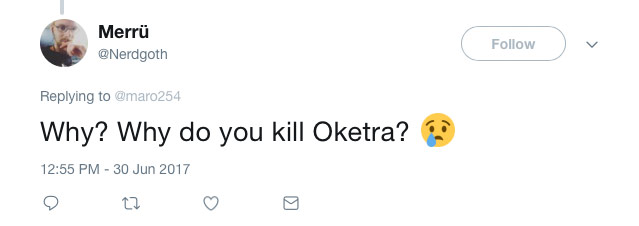
I actually have an alibi. I was doing design work on another set at the time.
The real question is why do we kill characters at all. Why can't everyone just live? The answer is that we're trying to tell an ongoing story, one with consequences. We don't kill creatures just to kill them, but we also don't remove it as an option. Character deaths are a tool, one that has to be used carefully and with purpose. Oketra's death was not done for shock value but because it was an important part of the larger story we're telling. Why did Bolas do what he did to Amonkhet? What role did the Gods play? What is Bolas up to? Why does he need an Eternal army? Why did he kill the Gods of Amonkhet? These are all important questions that we want you to ask and will answer as the story develops.
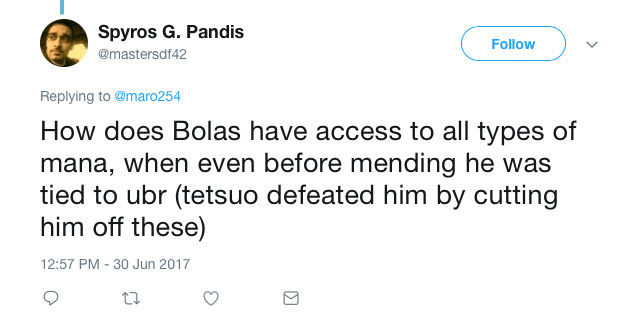
You're conflating two different things. There's the color of the character and there's the colors of magic that character can wield. The first is tied to what philosophies drive that character. Nicol Bolas is a blue-black-red character because he has traits of each of those three colors. He seeks knowledge and very much is driven to better himself. He is selfish and ruthless, willing to do whatever he needs to get what he wants. And he's a bit impulsive, driven more by his emotional state than even he is willing to admit.
As a mage who has lived over 25,000 years, he has learned to wield all five colors of magic. Yes, he leans toward blue, black, and red because those are the colors that come naturally to him, but he has taken the steps to learn white and green magic.
The reason most people conflate these two things is that in Magic we tend to make them one and the same. A mage wielding white magic is going to have a white philosophy. The nature of magic draws you to the types that are closest to what you are. It is exceedingly hard to learn magic outside of your personal colors, but it isn't impossible, especially for one of the smartest and oldest characters of the Multiverse.

That decision was more story-driven than anything else. In Amonkhet, we learn of the city of Naktamun and the desert that surrounds it. We show just enough of the desert to establish that it's a bad, dangerous place, and thus, it's a blessing that the city is surrounded by the Hekma, the protective barrier that keeps the desert out.
In Hour of Devastation, The Locust God shows up bringing locusts that eat through the Hekma, allowing the desert, and all its inhabitants, to enter the city. To portray this in game play, we made the choice to push off "Deserts matter" as a major theme to Hour of Devastation so that it could convey the invasion of the deserts into the city.
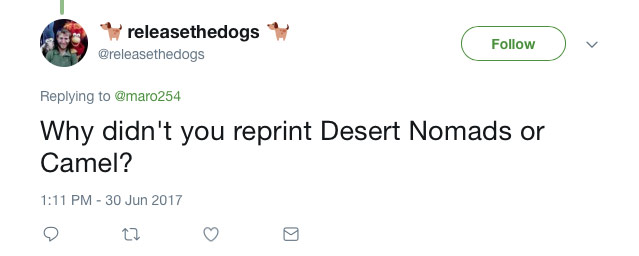
Both Camel and Desert Nomads are from Magic's first expansion, Arabian Nights.
Camel was off limits as a reprint because it uses banding, a mechanic we abandoned many years ago. Desert Nomads was off limits because it uses landwalk, an ability we more recently abandoned. (Swampwalk, forestwalk, etc. are all examples of landwalk.)
We did make sure to have Camels in the Amonkhet block as well as making Deserts mechanically relevant as a land subtype, but these two cards in particular just used mechanics we no longer support (in printing new cards—the rules are obviously supported for older formats).
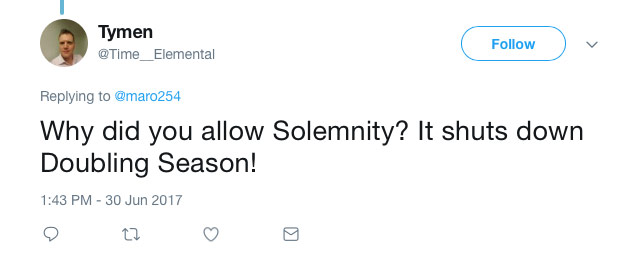
It also shuts down poison and energy and so many other things I love, but it's important for the game to have various answers to threats. One of the things this card is doing is something we've been thinking about for white, which is pushing more into white's proactive answers to threats. If white can anticipate the metagame, it can preemptively have the right answers. Plus, I love white's answers having answers, so that even once white shuts you down, there are things you can do to address it.
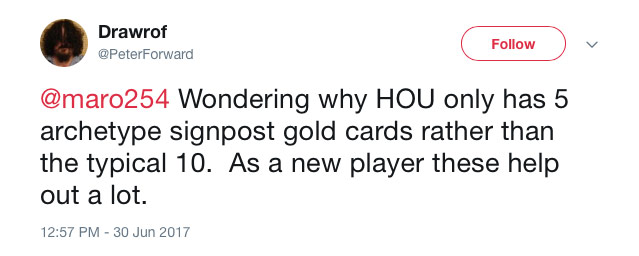
There are five ally multicolor cards in Hour of Devastation at uncommon, they just don't have a gold frame. The role that is traditionally filled with gold cards is carried by the five uncommon ally color aftermath cards. Admittedly though, while these fit mechanically into the ally color archetypes, they're a little less directional than the gold enemy uncommons.
The answer behind why is an ongoing theme this week and next, which is it's hard to fit everything into a small second set, so it requires you making lots of choices along the way in the design. We knew the players liked the aftermath cards, so we wanted to include more, but doing so ate up some of our uncommon multicolor space, which meant that something had to go.
I think a lot of people assume filling up your set is the hardest part of design but, in fact, the hardest part is having more than you need and cutting things. It's easy to get rid of something you dislike. It's much harder to get rid of something you love but that isn't pulling its weight within the set.
Our Hour Is Up
That's all the time I have for today, but fear not: you guys sent me so many good questions, I'll answer more next week. As always, I'm eager for feedback on my answers to your questions as well as on Hour of Devastation in general. You can email me or talk to me through any of my social media accounts (Twitter, Tumblr, Google+, and Instagram).
Join me next week for Odds & Ends: Hour of Devastation, Part 2.
Until then, may you explore Hour of Devastation and find even more questions about the set.
#454: Flashback
#454: Flashback
40:46
In this podcast, I talk about the mechanic flashback. I discuss how it got originally designed and the many different blocks that have used it.
#455: Complexity
#455: Complexity
44:08
In this podcast, I talk about the role complexity plays in game design.
- Episode 453 Amonkhet, Part 2 (24.9 MB)
- Episode 452 Amonkhet, Part 1 (28.5 MB)
- Episode 451 Becoming a Game Designer (26.5 MB)

